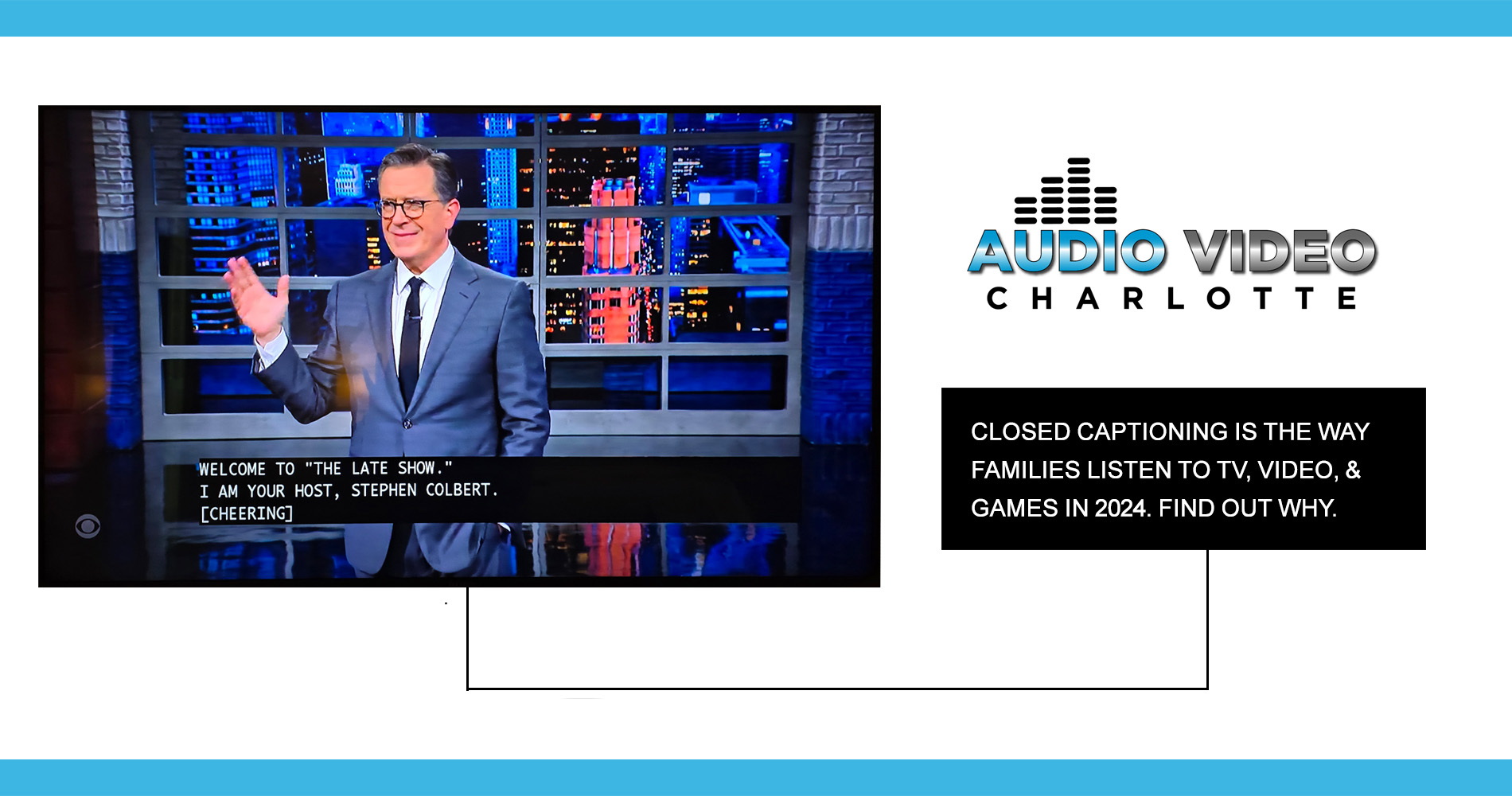The way in which we watch television has dramatically changed over the years. The TV used to be a large piece of furniture set front and center in the living room where the family would gather and watch one of a handful of available shows. Now, we hide our TV so it can easily be mistaken for a piece of art hanging on the wall. Instead of each household owning one box TV for the family to gather around, we have multiple television sets hanging in various rooms throughout the house so that individuals can watch their own shows or play games online. That’s not the only thing that has changed. How we watch is different too.
CBS This Morning recently conducted a report showcasing a change in the way we watch television–actually, not so much how we watch, but how we listen. According to CBS, “Over half of Americans keep subtitles (closed captioning) on some or all of the time” when watching TV. Weeding out the effect of peripheral noises is one clear reason for turning on the subtitles, but there is more to it than that. There is presently a more diverse pool of actors with accents, which can cause viewers to miss certain pieces of dialogue; there is also the fact that modern TVs are thin and typically project volume from the back, so once they are hung all the volume goes to the wall rather than towards those watching.
The main reason for the uptick of closed captioning usage, according to CBS This Morning, is that dialogue has simply gotten harder to hear. Because we have better mics that can capture every vocal nuance, there is more whispering and lower tones used in the shows we watch. Since actors don’t have to project their voices, the dialogue on TV has gotten quieter. Additionally, the takeover of digital sound has allowed more sounds to be mixed (music and dialogue, for example). This mix can make individual sounds difficult to decipher, causing vocal confusion.
Two Options for Better Sound
There is nothing wrong with using closed captioning, but many viewers notice they miss important visuals because they are busy reading the words at the bottom of the screen. On top of that, being able to hear and understand what we are watching is a big part of the experience, one we don’t want to lose out on due to peripheral noises, accents, quieter tones, and meshed sounds. Luckily, there is a way to get a crisp, clean sound from your television–as a matter of fact, there are two ways.
One option is to use a soundbar. A soundbar is a speaker (or a group of speakers) that connects and takes over the sound of your television. Depending on the quality of speakers you buy (at Audio Video Charlotte, we recommend going with Sonos), the dialogue and sounds coming from your TV will now be projected at you, the viewer, rather than out from behind the TV set.
Another option is to incorporate a receiver plus surround sound speakers so that you are completely engulfed with crystal-clear sound. We have found Denon and Marantz receivers to produce the cleanest sound. Both couldn’t be more user-friendly, and they are compact, high-performing receivers that can be paired with speakers placed nearly anywhere in and around your home. Best of all, you can control the wireless audio-video system with simple and intuitive apps on your smartphone or iPad. You don’t even have to get off the couch!
Which Option Is Best for You?
It’s not easy choosing between buying a soundbar or hooking up a receiver and surround speakers, but the best way to narrow it down, is to first consider your situation: are you trying to create movie theater-quality sound in your home, or are you mostly concerned with simply being able to hear what’s on the screen?
Here are a couple of similarities and differences between using a soundbar and a receiver plus surround sound:
● Both provide clear dialogue (much clearer than what the TV speakers provide) so that it is easier to decipher and understand different voices. That said, the receiver-based system will do a little better since the surround speakers create a fuller sound. The speaker drivers in a soundbar are smaller than standard speakers, which makes low frequencies difficult to hear at times.
● It’s shocking the amount of sound a Sonos soundbar can put out. Whether you are listening to a concert or watching a movie, you can definitely blast the sound without losing much quality or nuance. The power of a receiver and surround sound is a bit different, as it produces a more convincing and natural sense of envelopment because you can hear sounds transferring from one speaker to the next all around you. Think of it like this: a soundbar’s sound goes front to back (the sound projects from the front of the TV towards you and the back of the room), while surround sound spreads farther apart so you have sound coming from multiple directions simultaneously.
Unsurprisingly, incorporating a receiver and surround speakers does provide the best sound, but it is important to note that a soundbar, though not as effective, will make a big difference when it comes to sound clarity. It simply comes down to what sort of atmosphere you want, and how much money you want to spend.
Our Advice
If you are still having trouble deciding on your sound preference, here are a few pieces of information to help you along. Remember, it’s never too complicated or difficult when you rely on Audio Video Charlotte:
Use a soundbar for smaller rooms
If your main room for watching television is smaller, consider going with a soundbar over surround sound. Soundbars pack multiple speakers into one low-profile design that helps spread the sound evenly, and even though the sound quality is not as high as surround sound provides, having too many speakers in a small room can be counterintuitive. Nowadays, there are all kinds of soundbar shapes and sizes, so you are sure to find one to perfectly match your setting, but again, we highly recommend Sonos for clear, loud sound.
Hide your speakers in bookshelves
Your best option for premium sound is a receiver and surround speakers, where the speakers are strategically placed in separate locations. This helps the sound to envelop you as you watch and listen as the noise comes from different directions, such as left, right, and center. Rather than setting speakers on the ground around the room, where they can be trampled on and tripped over, consider placing the speakers on or in bookshelves—or other standing structures—positioned to the left and right of the television. Now your speakers are safely out of the way but able to provide an optimum level of performance. When looking at speakers, we recommend Martin Logan or Snap AV. Both are considered top notch and their durability is unmatched.
Mount your speakers up high to enable surround sound
The best sound is surround sound. This usually means six total audio channels—one for the center, one to the left and right, and two for the rear. Plus a subwoofer. The rear channel is usually the biggest challenge for people because most often they place this speaker too low. The rear speaker must sit high enough to engulf the room, so it can evenly spread the sound around the area. Try setting this speaker on a shelf or even fastening it to the wall. It’s worth it! We suggest using Episode speakers for wall and ceiling embedding, as they rate as one of the best for pushing sound down from on high.
Are you tired of reading captions rather than listening to the dynamic sounds of your favorite shows? If so, give us a call or come in and see us so we can help you get the perfect setup for your TV audio.






